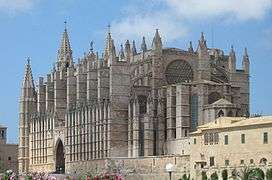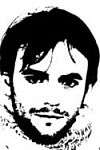2009 Palma Nova bombing
| 2009 Palma Nova bombing | |
|---|---|
| Part of the Basque conflict | |
| Location | Palma Nova, Calvià, Majorca, Balearic Islands, Spain |
| Date |
July 30, 2009 1:50 pm (UTC+2) |
| Target | Civil Guard barracks |
Attack type | limpet bomb |
| Deaths | 2 |
| Perpetrators | ETA |
The 2009 Palma Nova bombing occurred on July 30, 2009 when a limpet bomb went off outside a Civil Guard barracks in the town of Palma Nova, Majorca, Spain. The bomb was placed under a patrol car and two Civil Guard officers died as a result of the explosion. A second device was found under another Civil Guard vehicle at nearby barracks and safely exploded by police. On August 9, the Basque nationalist and separatist organisation ETA claimed responsibility for the attack, while four other bombs exploded around restaurants and shopping centres in Palma, Majorca, causing no injuries.
The bombing was ETA's first attack in Majorca since it tried to kill King Juan Carlos I in the summer of 1995, and its deadliest attack since it killed two Civil Guard officers in Capbreton, France in 2007. The attack came on the eve of the 50th anniversary of ETA's founding,[1] and days before the King's yearly visit to Majorca.
Background

In mid-2006, the organisation declared a ceasefire, and conversations between Batasuna, ETA and the Basque and Spanish governments started. Peace talks ended in December, when ETA broke the truce with a massive car bomb at the Madrid-Barajas Airport. ETA officially ended the ceasefire in 2007 and resumed its attacks around Spain. At the same time, dozens of members were arrested by Spanish and French police. Despite that, the organisation did not lose the capacity of carrying out attacks.[2]
In 2009, Patxi López became the first non-nationalist lendakari since the 1979 Statute of Autonomy of the Basque Country.[2] On June 19, ETA killed inspector Eduardo Puelles García in Arrigorriaga near Bilbao, Biscay, when a bomb attached to his car exploded[3] , and on July 9, a powerful bomb exploded in a Socialist Workers' Party local office in Durango, Biscay, causing no injuries.[4] In late July, it was reported that ETA was preparing its "summer campaign", with Spanish police looking for several vans the organisation had ready to explode.[5] On July 29, a van loaded with 300 kilograms (660 lb) of explosives went off in front of a Civil Guard barracks in Burgos, injuring 70, including women and children.[6][7]
The bombing was the first time since 2007 in which ETA killed more than one person in one of its attacks. On December 2, 2007 two undercover Civil Guards were shot dead in the French town of Capbreton, Aquitaine.[8] It was also the deadliest attack in Spanish soil since the Madrid-Barajas Airport.
The attack was the first time ETA had killed in Majorca, one of the Spanish regions less targeted by ETA. On August 18, 1977 a bomb was deactivated next to a seafront walk. On July 31, 1991 two people were injured after two bombs went off in Palma. Two months later, a car bomb was defused in Palma's main beach. In the summer of 1995, Spanish authorities dismantled a cell of ETA ready to shoot king Juan Carlos I.[9] In 2005, the organisation attempted the magnicide once more in Majorca.[10]
Attack
At 1:50 pm,[11] a 3 kilograms (6.6 lb) bomb placed under a Civil Guard Nissan Patrol went off,[12] killing officers Carlos Saénz de Tejada García and Diego Salva Lezaun. One of the officers died instantly, while paramedics failed to resuscitate the other officer. Both officers were inside the car when the bomb exploded.[13] The vehicle had been parked in the Na Boira street,[13] in front of a government-owned building used as a post office and Civil Guard barracks, among other functions.[11] Many hotels are located in the area, something which caused many foreign tourists, mainly German and British, to witness the blast.[13]
After the attack, authorities started to look for other possible bombs in the area, with the Civil Guard giving the order to search in all barracks on the island. Soon after, a detection dog found a bomb attached to another Civil Guard Nissan Patrol parked in front of a barracks located 1 kilometre (0.62 mi) from where the first bomb had exploded. The area was cordoned off and people evacuated from nearby houses and hotels. At 6:30 pm, Civil Guard bomb disposal officers TEDAX carried out a controlled explosion.[14] The bomb had been placed in a broken down vehicle and was therefore not in use.[12]
Victims
- Diego Salvá Lezaun (Pamplona, 1981) lived in Majorca and became a Givil Guard on August 25, 2008. He started working as an intern on January 31, 2009. A few months later, he suffered a motorbike accident which left him several weeks in coma. Once he recovered, he was assigned to the Palma Nova barracks, just four days before the attack took place.[11] He was buried in Palma.[15]
- Carlos Sáenz de Tejada García (Burgos, 1980) tried to join the National Police Corps after finishing his high school studies. He failed to do so and became a member of the Spanish Army, being stationed in an army barracks in Castrillo del Val. He joined the Civil Guard on February 18, 2008, and was sent to Majorca on July 19. He had some relatives affected by the July 29 bombing in Burgos, where he was buried.[11][15]
Aftermath

On July 31, a funeral was held at the Cathedral of Santa Maria in Palma. The service was attended by Primer Minister José Luis Rodríguez Zapatero and Prince and Princess of Asturias, Felipe and Letizia. Other people attending the mass were leader of the opposition Mariano Rajoy, Minister of the Interior Alfredo Pérez Rubalcaba and Patxi López, among others. At least 2,000 gathered outside of the cathedral and a minute of silence was held across Spain in memory of the dead.[16]
Operation Cage
Right after the attack, and suspecting that the bombers were still on the island, the Civil Guard and the National Police Corps launched a lockdown, an operation named Operation Cage (Spanish: Operación Jaula),[17] the biggest manhunt in the history of the island.[18] Similar operations had been done around Spain in other attacks, such as in the 2004 Madrid train bombings.[19] Checkpoints were set up across the island, while the Palma de Mallorca Airport and all ports were temporarily closed. The airport was closed at 4:00 pm and was re-opened at 5:55 pm, with several flights being delayed. During the rest of the afternoon, the ports were re-opened as well.[17]
The day after the attack, Spanish police released the picture of six members of ETA who could have possibly taken part in the bombing. Police named the suspects as Itziar Martínez Moreno, Iratxe Yáñez Ortiz de Barrón, Alberto Beraza Machain, Oroitz Gurruchaga Gogorza, Joanes Larretxea Mendiola and Iván Sáez de Jáuregui Ortigosa, although no direct evidence linked them to the attack.[20][21] Meanwhile, at least 1600 police officers were deployed to keep checking around the island, including on fisherman.[22] The intense search was still active in mid August.[23]
Reactions
During a press conference at the Moncloa Palace, Rodríguez Zapatero blamed both bombings "on the terrorist group ETA" and vowed to bring all of its members to justice: "They have no chance to hide, they can't flee, they can't escape justice, they will be arrested, they will be sentenced, they will spend their lives in jail".[24] When arriving on Majorca on August 1 for his yearly summer holidays King Juan Carlos I condemned the attack and vowed to "go on and on hitting them in the head and we must fight to stop them".[25] Condemnation also came from governments worldwide following the bombing:
 The European Commission condemned the bombing and gave its "total solidarity to the Spanish people and institutions".[26]
The European Commission condemned the bombing and gave its "total solidarity to the Spanish people and institutions".[26] German Chancellor Angela Merkel condemned the attack, and gave Rodriguez Zapatero her support in "the fight against terrorism".[27]
German Chancellor Angela Merkel condemned the attack, and gave Rodriguez Zapatero her support in "the fight against terrorism".[27] The Mexican Secretariat of Foreign Affairs condemned the killing.[28]
The Mexican Secretariat of Foreign Affairs condemned the killing.[28] Then Foreign Minister of Argentina Jorge Taiana condemned the Majorca and Burgos attacks.[29]
Then Foreign Minister of Argentina Jorge Taiana condemned the Majorca and Burgos attacks.[29]
August bombings
| Wikinews has related news: Three bombs explode in Majorca |
On August 9, the same day ETA claimed responsibility for the July 30 attack, four bombs exploded in three restaurants and one shopping centre around Palma. The bombs, which contained small amounts of explosives and caused little damage and no injuries,[30] went off after three warning calls from ETA. At 11:16 am local time, a man speaking on behalf of ETA called the firefighters of Calvià, warning that three bombs would go off in Palma. Half an hour later, another person also speaking on behalf of ETA called a taxi company in Gipuzkoa, giving details of the location and time the bombs would explode. Finally, another warning call was mistakenly made to the personal mobile phone of an inhabitant of Córdoba.[31] Authorities reported that the bombers had given contradicting details in each call, leading to confusion on the location of the bombs.[30]
The first bomb exploded at 12:00 pm in the bar "Nica", located in the avenue Comte de Sallent. The explosion was at first not reported, with authorities believing it was a gas explosion.[32] The second bomb exploded at around 2:25 pm in the "La Rigoletta" restaurant, in front of one of Palma's main beaches. The third bomb went off at around 4:00 pm in another restaurant, named "Enco". The fourth device exploded around 6:00 pm in a shopping mall located next to the main square of Palma. As a result of the few details given by the warning calls, police failed to evacuate the attacked restaurants. Nonetheless, no one was injured.[33]
Investigation
Authorities rapidly ruled out the possibility that ETA had a cell in the island, with police believing the attack had been carried out by a unit that had travelled to the island specifically to carry it out. Initial reports stated that the bombers had set the bomb off with a remote control.[13] Once the second bomb was spotted, police announced that it had a timer device, which could have allowed the members of ETA to plant the bomb several days before the attack and leave the island.[34] Earlier, Government delegate for Majorca, Ramon Socías, had said that security forces believed that the bombers had not left Majorca, and were hiding on the island, waiting for the situation to cool down before attempting to leave.[20]
Regarding the August 8 bombings, Alfredo Pérez Rubalcaba did not rule out any possibility, although he confirmed that the hypothesis of the bombers leaving the island before the attack was "reasonable", due to the timer devices.[31] All of the bombs had been planted in women's toilets, which led authorities to believe that they had been set by one of the two female suspects, Itziar Martínez Moreno and Iratxe Yáñez Ortiz.[34]
Arrests


On August 19, Alberto Matxain Beraza was arrested in the French town of Le Corbier in Savoy, next to the French Alps. He was held along with fellow ETA members Aitzol Etxaburu and Andoni Sarasola. They were responsible for ETA’s logistics operation, and had the job of supplying weapons and explosives to the ETA cells operating in Spanish soil.[35] The arrest led to the discovery of almost a tone of explosives, hidden by ETA in 12 small caches around France.[36] On October 11, Joanes Larretxea was arrested in Rivières, Gard along with top ETA member Iurgi Mendinueta Mintegi.[37]
Iratxe Yañez Ortiz was arrested on January 10, 2010 in Portugal after she was stopped in a routine traffic check-point in the Spanish town of Bermillo de Sayago, next to Spain-Portugal border. Yañez Ortiz was arrested along another member of ETA, Garikoitz García Arrieta, who was driving a van containing 10 kilograms (22 lb) of explosives, two pistols, a rifle and bomb-making material.[38] She was extradited to Spain on October 28, 2010.[39]
See also
References
- ↑ "ETA's anniversary calling card". bbc.co.uk/news. July 31, 2009. Retrieved 2010-12-19.
- 1 2 "Who are ETA?". bbc.co.uk/news. September 5, 2010. Archived from the original on 13 January 2011. Retrieved 2010-12-12.
- ↑ "Car bomb kills Spanish officer". bbc.co.uk/news. June 19, 2009. Retrieved 2010-12-12.
- ↑ "Bombers target Basque socialists". euronews.net. July 10, 2009. Retrieved 2010-12-12.
- ↑ "ETA podría tener otras dos furgonetas-bomba preparadas". diariovasco.com (in Spanish). July 30, 2009. Retrieved 2010-12-12.
- ↑ "Una furgoneta bomba de ETA explota junto a la casa cuartel de Burgos y causa decenas de heridos". rtve.es/noticias (in Spanish). July 29, 2009. Archived from the original on 28 November 2010. Retrieved 2010-12-12.
- ↑ "Coste del terrorismo – Perdidas económicas por terrorismo". ertzaintza.net (in Spanish). 2009. Retrieved 2010-12-12.
- ↑ "Funeral held for Spain bomb dead". bbc.co.uk/news. July 31, 2009. Retrieved 2010-12-12.
- ↑ "Atentado de ETA en Mallorca". elpais.com (in Spanish). July 30, 2009. Retrieved 2010-12-12.
- ↑ "ETA vuelve a atentar en Palma". elcorreo.com (in Spanish). August 9, 2009. Retrieved 2010-12-12.
- 1 2 3 4 "ETA mata a dos guardias civiles con una bomba lapa en un coche patrulla en Calvià". rtve.es/noticias (in Spanish). July 30, 2009. Archived from the original on 26 November 2010. Retrieved 2010-12-12.
- 1 2 "ETA puso tres kilos de explosivo bajo el asiento del copiloto en el segundo vehículo de Calvià". rtve.es/noticias (in Spanish). August 5, 2009. Archived from the original on 6 December 2010. Retrieved 2010-12-12.
- 1 2 3 4 "ETA mata a dos guardias civiles en el corazón turístico de Mallorca". elpais.com (in Spanish). July 30, 2009. Retrieved 2010-12-12.
- ↑ "Explosión controlada de una segunda bomba-lapa en otro coche patrulla en Calvià". rtve.es/noticias (in Spanish). July 30, 2009. Archived from the original on 28 November 2010. Retrieved 2010-12-12.
- 1 2 "Llega a Burgos el féretro de Carlos Sáenz, mientras Diego Salvá descansa ya en Palma". rtve.es/noticias (in Spanish). July 31, 2009. Retrieved 2010-12-12.
- ↑ "Los Príncipes de Asturias asisten al funeral de los dos guardias civiles asesinados por ETA". rtve.es/noticias (in Spanish). July 31, 2009. Retrieved 2010-12-12.
- 1 2 "Las fuerzas de seguridad activan en Mallorca la 'operación Jaula'". elmundo.es (in Spanish). July 31, 2009. Archived from the original on 5 December 2010. Retrieved 2010-12-12.
- ↑ "Spanish police step up Majorca hunt for Eta car bomb terrorists". telegraph.co.uk/news. August 1, 2009. Retrieved 2010-12-12.
- ↑ "El mayor atentado de la Historia de España". elmundo.es (in Spanish). Archived from the original on 26 December 2010. Retrieved 2010-12-12.
- 1 2 "Police release photos of Spain's 6 most wanted terrorists". elpais.com. July 31, 2009. Retrieved 2010-12-12.
- ↑ "The six most wanted ETA terrorists are probably on the run in Spain". surinenglish.com. August 13, 2009. Archived from the original on 10 January 2011. Retrieved 2010-12-12.
- ↑ "Despliegue policial sin precedentes en Mallorca para detener a los asesinos". elpais.com (in Spanish). August 1, 2009. Retrieved 2010-12-12.
- ↑ "La policía cree que la cuarta explosión de Mallorca también fue obra de ETA". cadenaser.com (in Spanish). August 10, 2009. Retrieved 2010-12-12.
- ↑ "Zapatero: "Los asesinos serán detenidos, condenados y pasarán su vida en la cárcel"". rtve.es/noticias (in Spanish). July 30, 2009. Archived from the original on 28 November 2010. Retrieved 2010-12-12.
- ↑ "Spanish royals holiday in Majorca, two days after deadly bombing". google.com/hostednews/afp. August 1, 2009. Retrieved 2010-12-12.
- ↑ "Atentado en Mallorca impacta a Europa". dw-world.de (in Spanish). July 30, 2009. Retrieved 2010-12-12.
- ↑ "Merkel condena el atentado y garantiza a Zapatero su apoyo contra el terrorismo". que.es (in Spanish). July 31, 2009. Retrieved 2010-12-12.
- ↑ "Condena México atentado con bomba contra Guardia Civil". oem.com.mx (in Spanish). July 30, 2009. Retrieved 2010-12-12.
- ↑ "Argentina repudia el atentado en Mallorca". eluniversal.com.mx (in Spanish). July 31, 2009. Retrieved 2010-12-12.
- 1 2 "Mallorca Shaken by Series of Bombings". spiegel.de. August 10, 2009. Retrieved 2010-12-12.
- 1 2 "Rubalcaba tranquiliza a los turistas y asegura que no son objetivo de ETA". rtve.es/noticias (in Spanish). August 11, 2009. Archived from the original on 26 November 2010. Retrieved 2010-12-12.
- ↑ "Los investigadores apuestan por que la cuarta explosión en Palma también fue obra de ETA". rtve.es/noticias (in Spanish). August 10, 2009. Retrieved 2010-12-12.
- ↑ "ETA vuelve a atentar en una zona turística de Palma con tres bombas de poca potencia". elmundo.es (in Spanish). August 9, 2009. Retrieved 2010-12-12.
- 1 2 "Los etarras colocaron las cuatro bombas de Palma antes de asesinar a los dos guardias civiles". rtve.es/noticias (in Spanish). August 10, 2009. Archived from the original on 26 November 2010. Retrieved 2010-12-12.
- ↑ "Alberto Machain Beraza, uno de los seis etarras más buscados poco conocido". rtve.es/noticias (in Spanish). August 19, 2010. Retrieved 2010-12-12.
- ↑ "ETA pierde en seis días una tonelada de material para fabricar explosivos". elmundo.es (in Spanish). August 25, 2010. Retrieved 2010-12-12.
- ↑ "Caen el 'número dos' del 'aparato militar' de ETA y otro de los etarras más buscados". elmundo.es (in Spanish). October 11, 2010. Archived from the original on 5 December 2010. Retrieved 2010-12-12.
- ↑ "Detenidos en Portugal dos presuntos etarras tras abandonar una 'furgoneta-bomba' en Zamora". rtve.es/noticias (in Spanish). January 10, 2010. Retrieved 2010-12-12.
- ↑ "Portugal entrega a España a la supuesta etarra Iratxe Yáñez". rtve.es/noticias (in Spanish). October 28, 2010. Retrieved 2010-12-12.
Coordinates: 39°30′53.58″N 2°32′3.37″E / 39.5148833°N 2.5342694°E